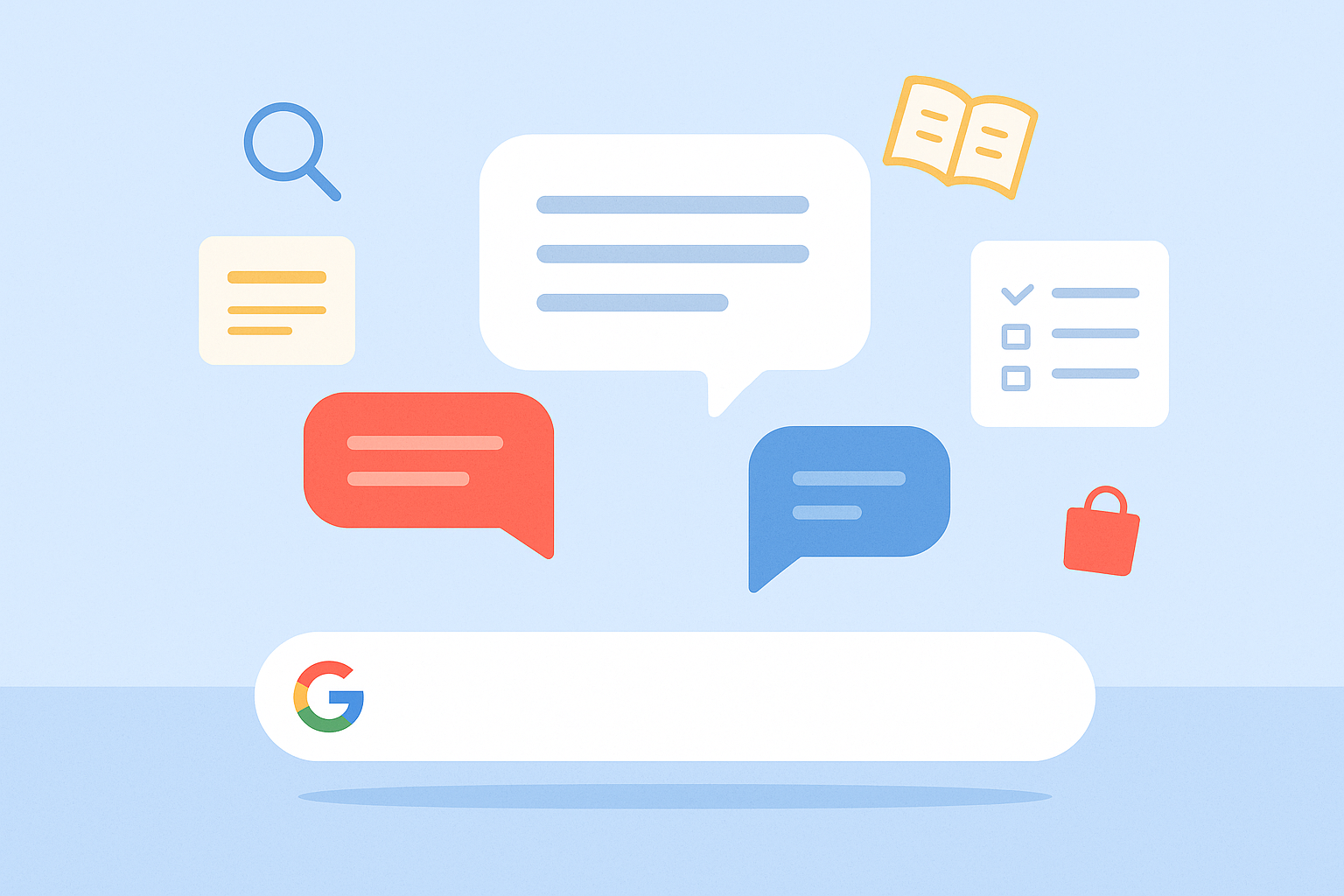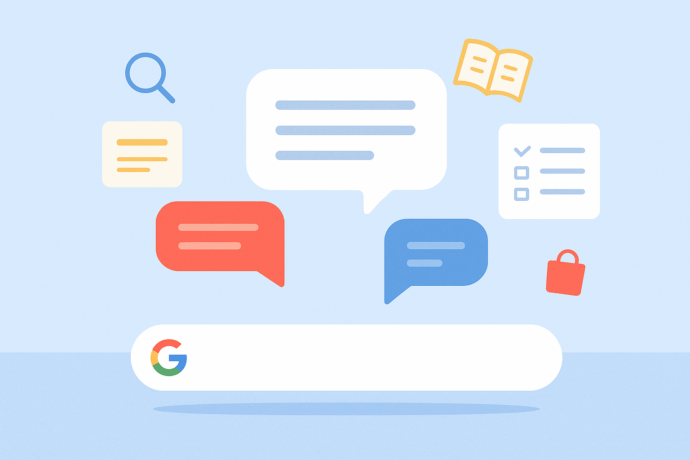Google’s latest release, AI Mode, marks a significant shift in how consumers discover, evaluate, and engage with content online. For digital marketers, it’s not just another feature to keep an eye on. It’s a paradigm shift that impacts how your brand is found, trusted, and chosen. Let’s take a look at what we know about AI Mode and what it’ll mean for your digital marketing strategy.
Here’s what AI Mode changes:
- Content is surfaced, not ranked. Structured answers now sit above traditional organic results.
- Search journeys are more conversational and intent-driven, not just keyword-matching.
- Visibility now depends on clarity, structure, and authority, not just SEO tricks.
- Users may view fewer pages, but take more meaningful actions when they do.
- Measurement needs to evolve. Traffic volume alone won’t tell the full story anymore.
A Shift from Search to Conversation
Until recently, traditional search behaviour followed a reasonably predictable path:
Input (a keyword) → browse results → manually compare options → make a decision.
Now, we’re seeing a transition to something much more fluid and intuitive:
Ask a question → receive a summarised response → set tasks → engage in follow-ups → make a decision.
With AI Mode Google is now so much more than just a search engine. It’s becoming a conversational assistant. Users don’t need to bounce between multiple tabs or interpret SERP snippets, they get immediate, synthesised answers drawn from multiple sources.

It’s efficient. It’s smart. And it’s going to dramatically change how people find your business.
Why AI Mode Exists And Why It Matters
Google’s not doing this purely out of innovation. It’s also strategic.
Products like ChatGPT and Bing’s AI chat (which Microsoft now uses to power its search assistant) have been quietly peeling away market share, especially when it comes to more exploratory or task-based queries.
Google’s AI Overviews were the first response. These provide quick answers within traditional search results. However, AI Mode takes it a step further, offering an entire search experience built on a conversational model.
Think of it this way:
- AI Overviews = Augmented Search
- AI Mode = AI-First Search
By launching AI Mode, Google is trying to claw back users it’s been losing to other platforms, particularly those who prefer chat-style queries. I’m predicting that Google will find a way to monetise this, likely through ads, sponsored responses, or premium placement within AI answers. While there’s no official confirmation yet, given Google’s huge profit margins and the decline in traditional search revenue, this seems a natural next step.
The Difference Between AI Mode and AI Overviews
The key difference lies in the user experience and underlying technology. AI Overview changes the traditional search results page by adding a summary or snapshot, but it doesn’t support interactive, back-and-forth conversations. In contrast, AI Mode is powered by Google’s Gemini model and functions more like ChatGPT, enabling dynamic, conversational interactions.
Interestingly, recent tests by industry expert Dan Petrovic reveal that AI Mode doesn’t pull page content directly from the live web, like traditional search does. Instead, it appears to access a proprietary content store separate from Google’s main search index. This means that AI Mode may not always have the most up-to-date page content and can sometimes fail to retrieve pages that are indexed and ranking in regular search results. It also raises some interesting questions about how Google handles content in AI Mode, and suggests we might have a bit more control over how their pages show up in this AI-powered experience.
What This Means for SEO
Now, for marketers, we need to discuss how AI Mode is already having an impact on search traffic.
Yes, people are still searching, and yes, search volume overall is still growing, but not all search is created equal anymore.
Conversational queries are often longer and more complex. And because AI Mode summarises the answer for the user, fewer people are clicking through to the original source.
In fact, early data suggests a 15–25% drop in click-through rates in some categories with AI Overviews. And AI Mode could push this even further.
That said, the traffic it does send your way is more qualified. These users are further along in their journey. They’ve had questions answered and are closer to taking action, which means higher intent.
The Takeaway for Digital Marketers?
You might get less traffic, but you’ll see more value per visit.
That’s if your content is showing up.

SEO Isn’t Dead, It’s Splitting
To stay ahead, leaders need to acknowledge the two faces of modern SEO:
- Traditional SEO: built around keyword targeting, page optimisation, and SERP performance.
- AI SEO: geared toward feeding Large Language Models (LLMs) with the right context, authority, and clarity to earn visibility in AI summaries.
It’s not either/or. It’s both.
And if your marketing strategy is only built around traditional SEO, you’re already falling behind.
So, What Should Digital Marketers Be Doing Right Now?
Let’s keep this simple. Here’s what you need to focus on:
1. Update Your Content Strategy
Conversational search demands different content. Think long-form, intent-driven, and structured in a way that LLMs can digest easily. That means using natural language, clearly answering key questions, and making sure your E-E-A-T signals are solid.
2. Revisit On-Page SEO
Yes, keywords still matter. But so do internal links, schema markup, headings, and content freshness. Think of it as making your content legible not just for Googlebot, but for the AI that sits behind it.
3. Measure What Matters
Visibility is everything, but so is reporting. You need tools and processes in place to see how AI search is impacting your traffic, and which pages are still driving commercial outcomes. Analytics should reflect both your search and AI performance.
The data below shows how traffic from AI-generated sources is starting to appear, and while it’s still early, as marketers, we should be keeping a close eye on this. Tracking these trends now will put you in a stronger position to adapt as AI search continues to evolve.
4. Stay Agile
This space is moving quickly. Platforms are evolving. Algorithms are adapting. Competitors are experimenting. Your team needs to stay educated and agile, ready to test, learn, and pivot as AI search continues to mature.
The Forseeable Future of Search is Chatty
AI Mode isn’t just a new tab in Google. It’s a signpost for where the future of search, and digital engagement, is heading, and this direction is less about ranking and more about relating.
Digital marketers who embrace this shift early will have a competitive edge, gaining more meaningful visibility, a stronger content strategy, and a greater share of high-intent traffic.
Those who don’t? They’ll still show up… just not where it counts.


